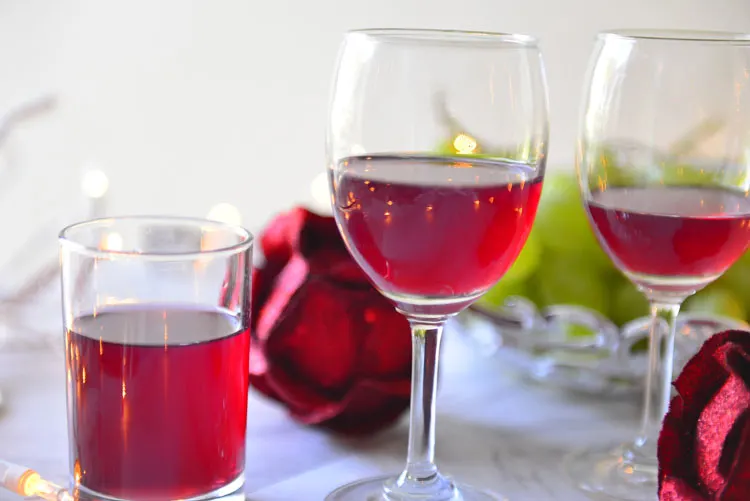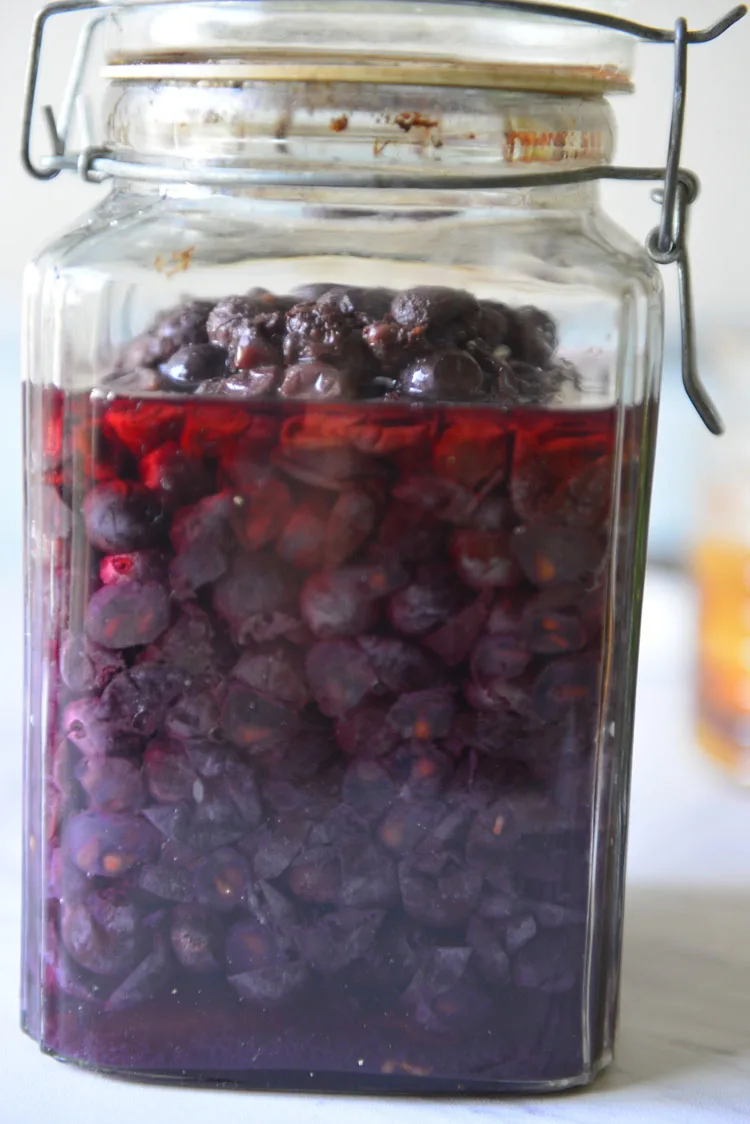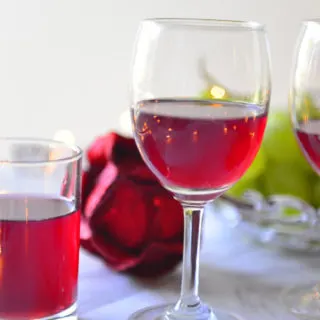This homebrew with grapes locally known as Munthiri wine is brewed with care at homes in the western ghats of India. Homebrewing has been part of human culture from the time we started wondering about what to do with the excess harvest. This grape wine is the result of such attempts by generations.
Contents

A sip of homemade wine and a slice of X’mas fruit cake is something we look forward to every year. The fruit cake is rich, full of spices, and studded with dried fruits while the homemade wine is full-bodied with just a hint of spices. One does not have to an expert winemaker or distiller to make this. To be fair it is more of a dessert than an alcoholic beverage. Grapes, sugar, and a touch of spice – these are all the ingredients you need. There is a secret ingredient here, time, a few weeks of it to be exact – but all that wait is entirely worth it.
Homebrewing in South India
Where I grew up, this kind of homebrewing was something half the population did, while the other half raised their eyebrows and wished someone would force them to try it. Humans are very resourceful, especially when it comes to our favorite food and drinks. So don’t be surprised if that bottle of arishtam – the Ayurvedic medicinal drink – that you found tucked away in the corner of the kitchen cabinet at aunt M’s place turns out to be something entirely different.
Drinks made from palm sap, cashew apples, and other fruits are popular throughout the region. The homemade versions range from mildly fizzy drinks to higher alcoholic concentrations that could knock you out in a sip. The ones made at home usually tend to be on the milder side, but always exercise caution if someone offers you one of these.
Coming back to the wine in hand – I remember my mom fermenting gooseberries with spices to make this delicious Nellikka Arishtam. Nellikka or Gooseberries are packed with nutrients and this was a delicious way to make us all eat it! It wasn’t until we all left home that she decided to take winemaking more seriously! Makes you wonder what brought it on! Anyhow the last time I visited she had this amazing chambakka (rose apple) wine waiting for me. Love you AMMA – you are the best ♥

My Grape Wine Journey
Getting back to my wine journey a little over a decade ago we had planted a couple of grapevines in our backyard. Only one of them took and we found out that it produced these nice plump Concord grapes, the only catch was the seeds. Kids (and some grownups) now seem to be offended by the errand seed! Apparently, we have become such fragile creatures that a few seeds can ruin our day! Anyhow there was plenty leftover.
So there I was left with about 60 lbs of dark purple grapes. There are some resourceful ladies I know, who would have turned these to raisins, or made jams and squashes. But what did I do? Well like a proud Malayali, I went back to my roots and made wine. Was that a mistake? Yes, of course, big time. As it turns out now I have to make it every year!
Choosing Grapes
In commercial winemaking there are prized varieties of fruit, but not so in homebrews. And each batch develops its distinct flavors. So use what you have.
The thing to keep in mind is that the grapes in the supermarket are usually treated with chemical agents to inhibit the growth of fungi and bacteria. These prevent fermentation. We can use products to clean out the chemicals and add yeast to kick start fermentation. But that is not a path I advise or like to take. For one it is too much work and for another, there will be traces of chemicals remaining. Home brewing is all about sitting back and enjoying life. So I would rather go out and look for organic untreated grapes.
Traditional Recipe for Homemade Grape Wine
Traditional recipes use equal quantities of fruit and sugar. The concoction age for less than a month. This makes a sweet drink with minute traces of alcohol. The same concoction when allowed to ferment longer, 3 months or more, develops more complex flavors. If you are buying this from a local bakery in the Western Ghats, you will be getting the sweet version, with nary a trace of alcohol.
Most of the traditional recipes call for boiled water and wheat kernels or yeast as a starter. In my experience, the organic grape does not need any starter as the ambient yeast does a great job. To me adding commercial yeast changes the microbial content and the final product has one flat flavor instead of the more complex, nuanced flavors each crop and season create.

The process of making grape wine is pretty easy. The most important part is to keep everything clean and dry. The utensils, the fruit, and anything else that you use in the process should be clean and dry. Wash and dry the grapes. Layer the grapes and sugar in the container in alternating layers. Top with a layer of sugar. Make sure that the container is large enough to hold the fruits and fill about 2/3 of the way. This is an added insurance against overflow during fermentation.
Traditionally Bharani, large ceramic containers, were the jars of choice. The idea is to use non-reactive containers. I have seen terracotta and ceramic used for this, never plastic or metal. Here I have used glass. When using glass containers cover them with clothe/brown paper bags to prevent the light from getting in. All you have to do now is to wait for the yeast and bacteria to work their magic.
Many recipes call for mixing the contents once a day for a few days. I find this to be unnecessary if there is enough room for expansion in the jar. If the CO2 generated can escape slowly then there is nothing to worry about. If you are unsure, then check on the jar every other day for the first week and open the lid to vent if necessary.

Now that is a feast for the eyes! Strain the clear liquid and enjoy !

Home Made Grape Wine
Ingredients
- 500 g Grapes 1 lb
- 250 – 500 g Sugar 1 to 2 C
Optional
- 1 Cinnamon Stick
- 3 Cloves
Instructions
- Remove the grapes from the stem, wash and dry well.
- Clean and dry a large non reactive jar (see notes).
- Measure the sugar and set aside. Adjust sugar per taste, use equal amount in weight of the grapes for the sweet wine.
- Divide the sugar and grapes into equal number of portions. Take one portion of the grapes and place in the jar. Crush it lightly with the back of a wooden spoon so the juices begin to ooze out. Layer a portion of the sugar.
- Repeat this process until all the fruit is used up. Crush the last layer of fruit and add the add the cinnamon stick and cloves. End with layer of sugar.
- Close the lid and store in a dark place, away from light and heat.
- 24 hours later shake the jar lightly to distribute the sugar and spices evenly. Repeat this process for 5 days. If the mix froths to the top open the lid a little to vent. Close and return to the storage area.
- Keep the jar undisturbed for at least 21 days. For more complex flavors keep it for 3 months. Open the jar and strain the juices into a clean dry bottle.
- Serve chilled.
Notes
- Use whole spices and organic grapes.
- Fill the jars only 2/3 of the way through.
- Keep the jars away from sunlight. If using glass jars cover with brown paper bags or clothes to block light.
Important: Nutrition Values are estimates. Actuals vary based on ingredients and serving size.
After staining off the clear liquid, squeeze the fruit to extract every last bit of goodness from it. You could as well, but the second extraction is not as flavorful as the first.
Disclaimer: The views expressed here are my personal views and need to be taken with a pinch of salt – or a bottle of good wine as the case may be. While open to interpretation please use your judgment when making and consuming alcoholic beverages and at all times obey the local laws.


Manju
Tuesday 4th of October 2022
Hi, thank you for this recipe, planning to try this year for Christmas, i see many recipe comes with adding small amount of whole or broken wheat, wud you suggest it too
Syama
Thursday 20th of October 2022
@manju Wheat is used as a starter, not needed if you have good clean organic grapes.
Kim
Thursday 22nd of September 2022
This is my first time making wine and following your recipe.Using homegrown Concord grapes. Can’t wait to taste the final results!
Mary
Friday 27th of May 2022
Thank you!
Rachael
Sunday 5th of December 2021
How long will the wine last once drained and put in a new container and sealed?
Syama
Tuesday 7th of December 2021
That is a good question, which I am afraid I don't have the answer for. I can confirm that it stays good for a year, but never been able to keep it longer:-)
Lia
Thursday 7th of October 2021
This iS my first time making your wine my question is. The hissing sounds from my jars is this okay?
Marie
Friday 15th of April 2022
@Syama, loosen the lid to let the air out
Diana k
Sunday 24th of October 2021
@Syama, Can i add more sugar after few months if i want to increase the alcohol content and wait another month or is that not recommended? I wasn't sure if I added enough in the first place that's why..
Syama
Saturday 9th of October 2021
Hmmm.. I never had hissing sounds, but I imagine it is the bubbles (CO2) trying to escape. As long as the gases aren't building up it is OK.